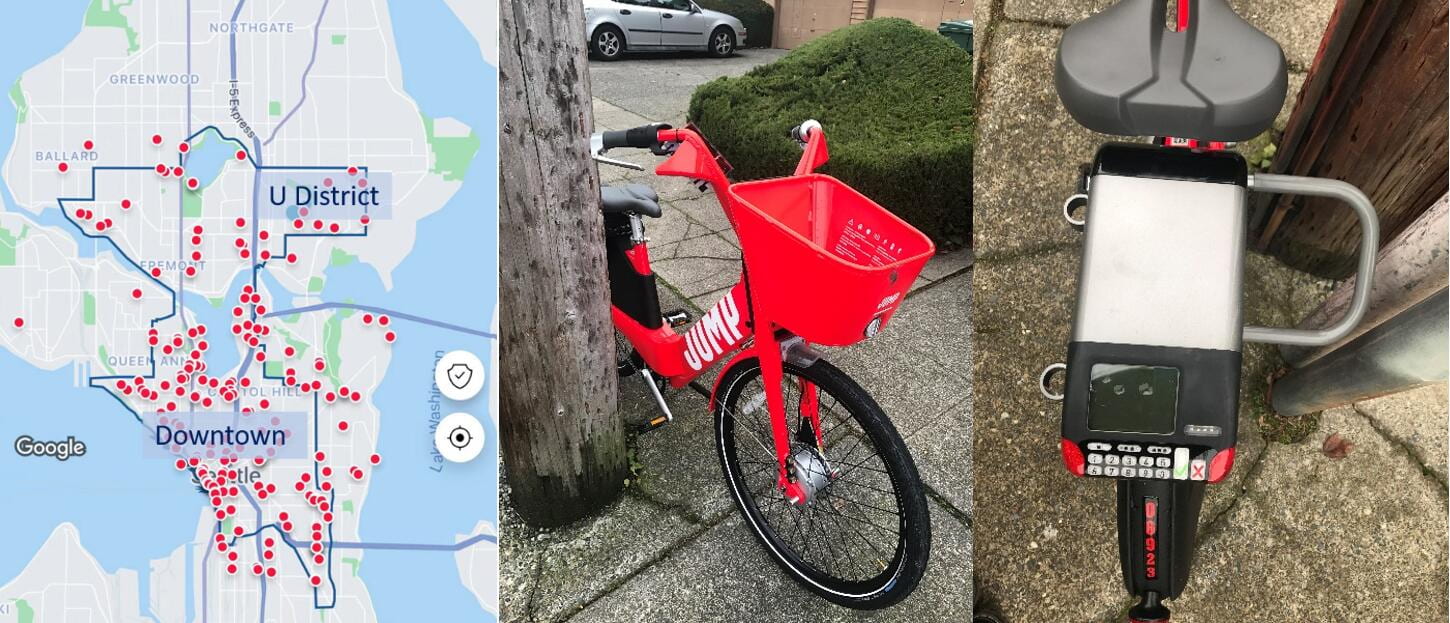November 29, 2018
How to Regulate Bike Sharing Parking? -Reflection after Trying Seattle’s JUMP Bike
Tianqi Zou
When I first visited Seattle last April, there were three bike sharing companies operating in the city, ofo, Spin, and Lime. However, when I returned in September, ofo and Spin had already left the market, and Lime has been in a monopoly position for several months. Last week, Uber’s JUMP launched its bike sharing program in central Seattle with about 300 electric shared bikes, bringing new energy and a new round of competition in shared transportation to the city.
I was very excited about the news and wanted to try the new bike as I had never seen a JUMP bike before. To locate a bike, I figured out that the existing Uber app on my smartphone could also be used to find a JUMP bike, so I did not download the JUMP app designed solely for the bike sharing program. When I opened the bike location map, it seemed that bikes were more densely distributed downtown, with only a few near me in the U district area. Conveniently, the app allowed me to reserve a bike for up to 30 minutes, so although it was a long walk to the nearest bike, at least the reservation function guaranteed me a ride. This is a big improvement over Lime.

The JUMP bike I used was brand new in a bright red color, equipped with a small screen and a keypad on the top of the back wheel, as well as a u-shaped bar locking the bike. Instead of scanning a QR code to unlock (as one does with Lime bikes), the JUMP bike asked me to use the keypad on the bike to enter a 4-digit code appeared on my app. Alternatively, users can also type in their account number or tap their ORCA card to unlock. Instructions for linking an ORCA card can be found on the screen. I think the ORCA card option is quite creative and both the alternatives provide greater convenience to people who are unable to use a smartphone, such as those who don’t have a smartphone, or don’t have it with them, or whose battery is dead. JUMP’s e-bike also allows riders to change gear while riding, which Lime e-bikes do not. Another big difference is that when locking the bike to end the trip, although currently it is not a requirement, JUMP lets users lock the bike to a rack or a pole using the u-shaped bar, so that the bike will not easily fall down or be misplaced. However, it is hard to make this idea a required parking rule as it is costly to install sufficient supply of bike parking facilities to meet the goal of parking “anywhere”.

Speaking of inappropriate parking behavior, which has been a headache for the rapidly growing bike share market in China as well as in American cities, I recently noticed that the Chinese government is seeking to implement new parking rules, one of which is using electric fence to regulate parking behavior. When hearing the term electric fence, I would normally think of an agricultural fence or a fence that protects natural reserves. However, in the context of bike share parking, it refers to a virtual parking box, not a physical “fence” installed on the ground. The electric fence uses GPS and other radio identification technologies to define the parking zone and measure the proximity of a bike to a parking zone. A detailed technological explanation can be found at https://www.smartlockssupplier.com/news/Technology-principle-of-sharing-bike-electric-fence.html. The parking rule is that when ending the trip, riders have to park their shared bikes within the designated zone defined by the electric fence, otherwise they will not be able to lock the bike and the app continues counting service time and charging money, with variations of award and punishment regarding this rule.
Beijing and Shanghai have rolled out pilot projects using electric fences for shared bike parking with the collaboration of the government and bike sharing companies. There are also new studies on electric fence planning, such as Y. Zhang et al.’s work using Mobike’s data in Shanghai to develop an electric fence plan that meets the parking demand in Shanghai.

So far, I think electric fence is a possible way to solve inappropriate shared bike parking problems, which Seattle could consider as a means of regulating parking behavior as the market continues expanding. Or it might be better to have a combination of the technology of electric fences and physical racks, so that shared bikes will neither be misplaced nor fall down due to extreme weather or incautious human activities. However, either electric fence or physical racks could bring bike sharing back to a stage similar to station-based bike sharing, reducing the freedom of usage. Thus, it seems that there is always something to compromise either to regulate or not, and efforts are still needed for better solutions.
Recent Comments